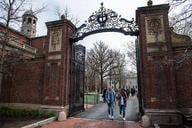You have /5 articles left.
Sign up for a free account or log in.
I was reading the recent piece in The Atlantic about the partnership between Starbucks and Arizona State University. The title is misleading because the program is so new that no one has yet graduated and “benefited” from having a degree, but it does present a nice click-bait headline, coupled with a framing narrative from a long-time, older service worker who can’t get ahead because she doesn’t have a degree.
But what I kept coming back to over and over again was the importance of relationships in the success of the students profiled. It’s unclear if it was a narrative choice, but it must have come up enough times in the stories from the students that it became one of the central part of the piece. This is not surprising, as my blogger-in-arms John Warner has noted time and time again, that success for students relies on the relationships they forge with mentors and professors.
The book How College Works (which John reviewed here and I reviewed at WIHE) shows through research how much the relationships matter. How College Works, however, focuses on the small, liberal arts institution. The Atlantic article points out that many (ok, they imply that just about all) institutions of higher education aren’t equipped to provide the level intimacy (they used the word! I feel vindicated) that students need to be successful. As proof, they use the fact that ASU has outsourced advising, both on the admissions side and the academic side.
Outsourced intimacy.
I tweeted out that there are plenty of professors who long to make those kinds of connections with students because they are overworked, underpaid, and off the tenure-track. The idea of divorcing the intimacy between educator and student, I think, ultimately reduces the educational experience and the learning that happens. But on the other hand, I’ve met entirely too many professors who, in the name of professionalism, insist on keeping students at a distance, and truly don’t see their jobs as ensuring student success but instead as gatekeepers weeding out the unworthy.
(Before you get all #notallprofessors on me, I’m not talking about YOU. I’m talking about that colleague you know. Because you know them.)
The other element that stood out to me while reading How College Works is the complex set of networks the students develop and that the richer the network, the more likely they are to succeed. There is increasing research on the importance of networks and communities in learning (see, for example, the current iteration of #rhizo15). Starbucks and ASU are working on developing online social networking spaces to provide a community and network for the employees involved in the program.
Finally, I couldn’t help but notice where these Starbucks employees had gone to school before dropping out: underfunded public institutions. It reads like the usual suspects: Community college dropout. Fell behind because of remedial coursework. Large public far from home and drowning in debt. Athlete who loses his scholarship. My fear is that this experiment becomes another excuse for state legislatures to defund those institutions that serve the most students. Ultimately, the Starbucks program will impact less students than a small liberal arts college. But those successes that they do have could help inform funding and policy to help those institutions who are devoted to serving these particular populations of students (despite the inflammatory rhetoric in the article that asserts, as opposed to argue, the contrary).

